|
Mehrangiz Manouchehrian (1906 – 2000 AD) was both Iran’s first female lawyer and first female Senator. She was a lawyer with tremendous command of the materials of law; a feminist who fought relentlessly against discrimination; and was highly respected by the authorities and her peers in the Senate. It was during the time when the Pahlavi government strove to give women’s more rights, that using her experience as a lawyer she drew up the Family Protection Act, one of the most progressive of its time. The conservative clergy did not approve of her proposed bill, not only because they claimed it was against Islam, but because they wished to preserve their power and material advantages which they gained by their involvement in the affairs of the family. They called her a heretic and traditional forces in the society threatened her. In fear for her safety, Mehrangiz fled Tehran for some time. It was only later, with the effort of more women, who convinced the parliament and leveraged modernist religious jurists, that the bill became law under the name of the Family Protection Act of 1967. It underwent further changes in 1975 to conform better to the interests of women.
The law contributed to women in various ways such as increasing the minimum age of marriage to 18 and allowing them to ask for a divorce. Prior to the 1975 law, a man could marry up to four wives but because of this bill, he could not marry a second wife without the consent of the first and marrying a second wife constituted sufficient cause for a woman to divorce her husband. When Mehrangiz spoke publicly in the Senate against a law that forced women to get their husband’s permission before traveling abroad, Prime Minister Sharif-Emami insulted her. Exasperated, Mehrangiz finally resigned. Sharif-Emami later apologized to her privately, but she demanded a public apology which he refused. Mehrangiz Manouchehrian was awarded the United Nations Prize in the Field of Human Rights in 1968 for promoting women’s rights. After the 1979 Islamic Revolution, the Family Protection Law was revoked, and Iranian women lost all the rights that they had fought for. ------------------------------------------------------------------------------ References:
Mehrangiz Dowlatshahi (1919 – 2008 AD) was the first Iranian female ambassador before the 1979 Islamic revolution, who dedicated her life to fighting for women’s rights. She held several significant positions including being one of the first female members of parliament.
She was born to a powerful and established family. Her mother was of the renowned Sadeq Hedayat family and her father was a progressive man who believed in equality between men and women. He was in fact one of the few men who had encouraged Reza Shah to end compulsory veiling. Mehrangiz attended a high school run by American missionaries and graduated in 1936 when she was only 15 years old. Even before Reza Shah banned the veil, she and some other students, would refuse to wear the veil and bravely appear in public wearing a hat. Her father died before he could send her to Europe to further her education and her grandfather was a much more traditional man who was against sending a single young girl to Europe. He finally allowed her to go in the company of relatives. Mehrangiz studied in Germany and received a PhD in social and political science from Heidelberg University. Upon returning to Iran, she worked for several social services organizations. Eventually she established the Rah-e No (New Way) Society, which offered adult literacy programs and advocated equal rights for women. She served as a member of the parliament from 1963 to 1975 and contributed significantly to the passage of a new family law especially regarding women’s rights to file for divorce, which until then (as it is now again) a monopoly right of men. The Pahlavi government had to act with caution since it did not want to anger the clergy and bring about a political crisis. Finally, she became the first woman ambassador of Iran. After the 1979 revolution she moved to Paris where she published a book titled “Society, Government and Iran’s Women’s Movement.” She died in Paris in October 2008. ------------------------------------------------------- References:
|
Details
AuthorSaghi (Sasha) Archives
May 2019
Categories |


 RSS Feed
RSS Feed